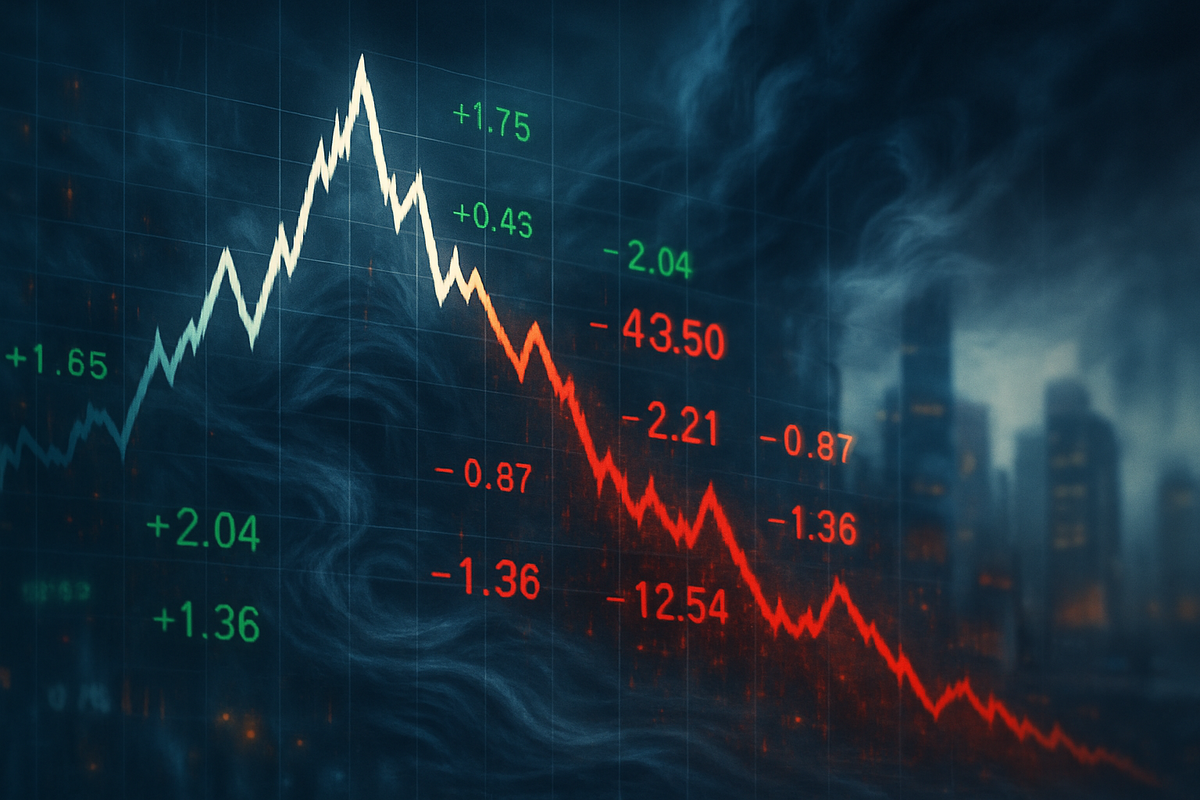
Wall Street experienced a jarring session on a recent Wednesday, as the Dow Jones Industrial Average erased a substantial 400-point gain, turning lower and underscoring the persistent choppiness that continues to engulf financial markets. This abrupt reversal, where stocks gave up earlier advances, serves as a stark reminder of the heightened volatility and underlying uncertainty that investors are navigating in the current economic climate. The event highlights a market grappling with conflicting signals, where initial optimism can quickly yield to apprehension, leaving participants wary of sudden shifts.
The day's trading reflected a broader pattern of indecisiveness, with significant intraday swings becoming a more common feature of market behavior. Such erratic movements can erode investor confidence, making it challenging for both institutional and retail investors to pinpoint clear trends or make long-term strategic decisions. As global economic narratives evolve and geopolitical tensions simmer, the market's propensity for these dramatic reversals is likely to remain a dominant theme, demanding a more agile and cautious approach from all stakeholders.
The Day's Dramatic Reversal: Unpacking the Choppiness
The Wednesday in question began with a strong upward momentum, fueled by a confluence of positive market drivers. Reports of easing trade tensions, robust corporate earnings projections, and a general sense of economic recovery had initially propelled the Dow (INDEXDJX: .DJI) significantly higher, at one point reportedly gaining over 1,100 points. This early surge suggested a renewed bullish sentiment, with investors seemingly eager to embrace risk.
However, as the day progressed, the initial euphoria dissipated. A wave of selling pressure materialized, systematically chipping away at the gains. By the closing bell, the index had not only given back a significant portion of its impressive intraday rally but had also dipped into negative territory before ultimately settling with only a fraction of its peak gains, indicating a net erase of over 700 points from its high. This abrupt turnaround left many market participants bewildered, highlighting the fragile nature of current market sentiment.
Several factors typically contribute to such dramatic intraday reversals and persistent market choppiness. Economic data releases, particularly if they surprise market expectations, can trigger sharp reactions. Geopolitical events, such as ongoing trade disputes or regional conflicts, inject uncertainty that can quickly shift investor sentiment from optimism to caution. Corporate news, including unexpected earnings disappointments or revised guidance from heavily weighted Dow components, can also catalyze broad market movements. Furthermore, technical factors like profit-taking after significant gains, algorithmic trading exacerbating rapid price swings, and shifts in overall investor psychology (fear vs. greed) play crucial roles in these volatile swings. The day's events likely saw a combination of these elements at play, as traders locked in profits and concerns resurfaced, overshadowing earlier optimism.
Companies Navigating the Crosscurrents
Market choppiness and sudden reversals disproportionately impact certain industries and public companies. Sectors that are highly sensitive to economic cycles, consumer confidence, and global trade dynamics tend to bear the brunt of such volatility, while others might demonstrate greater resilience or even find opportunities.
Technology (NASDAQ: QQQ) companies, often characterized by growth-oriented valuations and sometimes speculative investor interest, are particularly vulnerable. Giants like Apple (NASDAQ: AAPL), Microsoft (NASDAQ: MSFT), and Amazon (NASDAQ: AMZN) can experience amplified price swings. Investor sentiment shifts can lead to substantial corrections for companies with stretched valuations, impacting their ability to attract capital and potentially slowing their ambitious expansion plans.
Consumer Discretionary (NYSEARCA: XLY) firms, which rely on consumers' disposable income for sales (e.g., retailers, entertainment, travel), also face significant headwinds. When market uncertainty increases, consumers tend to tighten their belts, directly affecting the top and bottom lines of companies like Starbucks (NASDAQ: SBUX) or Walt Disney (NYSE: DIS).
Financials (NYSEARCA: XLF), including major banks like JPMorgan Chase (NYSE: JPM) and Goldman Sachs (NYSE: GS), are deeply intertwined with broader economic health and credit flows. Choppy markets can lead to concerns over net interest margin compression, deteriorating credit quality, and reduced investment banking fees, impacting their profitability and stock performance.
Industrials (NYSEARCA: XLI), such as Caterpillar (NYSE: CAT) or Boeing (NYSE: BA), are sensitive to global trade, manufacturing output, and infrastructure spending. Trade tensions and economic slowdowns can directly impact their order books and supply chains, making them susceptible to market shifts. Energy companies (NYSEARCA: XLE) also face high volatility due to fluctuating commodity prices, which are often influenced by geopolitical events and global demand. Companies in these sectors must prioritize robust risk management, transparent communication, and flexible operational models to navigate turbulent market conditions successfully.
Wider Significance and Historical Context
The persistent market choppiness and sudden reversals, exemplified by the Dow's recent dramatic turn, carry broader significance for the economy and financial landscape. This environment reflects a market in a state of heightened uncertainty, where conflicting signals prevent the establishment of clear, sustained trends.
This trend fits into broader industry dynamics marked by ongoing geopolitical tensions (e.g., U.S.-China trade relations), the delicate navigation of monetary policy by central banks like the Federal Reserve, and the pervasive influence of technological advancements, particularly in AI, which can create both immense opportunities and speculative bubbles. The procyclicality of the financial sector means that banks and investment firms often amplify economic cycles, reacting swiftly to shifts in economic sentiment. The ripple effects extend across the economy: competitors with stronger balance sheets might seize opportunities, while weaker ones struggle. Business partners, from technology providers to real estate markets, feel the squeeze as lending tightens. The broader economy experiences reduced consumer spending, higher borrowing costs, and challenges in capital access for both public and private companies.
Historically, periods of extended market volatility are not uncommon. The Dot-Com Bubble Burst in the early 2000s, the Global Financial Crisis of 2008, and the rapid COVID-19 pandemic-induced crash of 2020 all demonstrated how quickly markets can reverse course and how prolonged uncertainty can persist. While these events caused significant downturns, history also shows the market's remarkable resilience and capacity for recovery over the long term. Regulatory bodies often respond to such volatility by increasing scrutiny on financial institutions and discussing measures like constraints on short selling or financial transaction taxes, though their effectiveness remains a subject of debate. The lesson from these precedents is clear: while volatility is an inherent part of market cycles, a diversified, long-term investment perspective is crucial for weathering the storm.
What Comes Next: Navigating the Unpredictable
Looking ahead, the market's trajectory remains uncertain, with both short-term challenges and long-term possibilities emerging from the current choppiness. In the short term, investors should anticipate continued erratic price swings, with potential for rapid gains followed by quick reversals. This environment makes it difficult to hold trades for extended periods and elevates the risk of losses for those without stringent risk management strategies. Emotional trading, driven by fear and greed, is likely to be amplified, leading to impulsive decisions.
However, these conditions also present unique opportunities. For nimble, active traders, the high volatility can create chances for quick profits, albeit with significantly elevated risk. For long-term investors, market corrections and dips may be viewed as strategic opportunities to acquire quality assets at a discount, potentially boosting returns over time. Companies, in turn, must prioritize agile decision-making, invest in innovation and digital transformation, and diversify revenue streams to enhance resilience. Strategic adaptations include focusing on cost efficiencies, strengthening supply chain responsiveness, and fostering a culture of adaptability.
In the long term, historical patterns suggest that markets tend to recover and often exceed previous levels. The current choppiness could be a period of consolidation, or "building cause," before a more significant trend eventually emerges. However, risks remain, including the potential for deeper corrections if negative macroeconomic data intensifies or if speculative bubbles, such as those fueled by AI euphoria, burst. Scenarios range from prolonged sideways action with sector rotations (e.g., defensive sectors outperforming) to more significant "waterfall declines" if key support levels are breached. Investors must embrace diversification, dollar-cost averaging, and a disciplined, long-term focus, while companies should leverage continuous market analysis and robust risk management to navigate these turbulent waters.
A Comprehensive Wrap-Up: Preparing for Enduring Volatility
The Dow's recent dramatic reversal serves as a potent microcosm of the broader market sentiment: a landscape defined by persistent choppiness and the constant threat of sudden shifts. The key takeaway from this event is the imperative for vigilance and adaptability in an environment where even significant intraday gains can evaporate in a matter of hours. This volatility is not merely a fleeting phenomenon but appears to be an enduring characteristic of the current financial climate, shaped by a complex interplay of economic data, geopolitical tensions, corporate performance, and investor psychology.
Moving forward, the market is likely to remain highly sensitive to incoming news, whether it pertains to inflation figures, interest rate policy, or developments in global trade relations. Investors should prepare for continued uncertainty, with a greater emphasis on capital preservation and risk management over aggressive growth strategies. The ability to identify high-quality companies with strong fundamentals, regardless of short-term market noise, will be paramount.
What investors should watch for in the coming months includes the trajectory of inflation, the Federal Reserve's stance on interest rates, the evolution of international trade negotiations, and the resilience of corporate earnings. Companies, especially those in cyclical or growth-oriented sectors, will need to demonstrate strong operational flexibility and robust balance sheets to weather potential storms. Ultimately, the recent market choppiness underscores that a disciplined, diversified, and long-term investment approach, coupled with a keen awareness of macroeconomic and geopolitical developments, will be crucial for navigating the unpredictable journey ahead.
This content is intended for informational purposes only and is not financial advice







